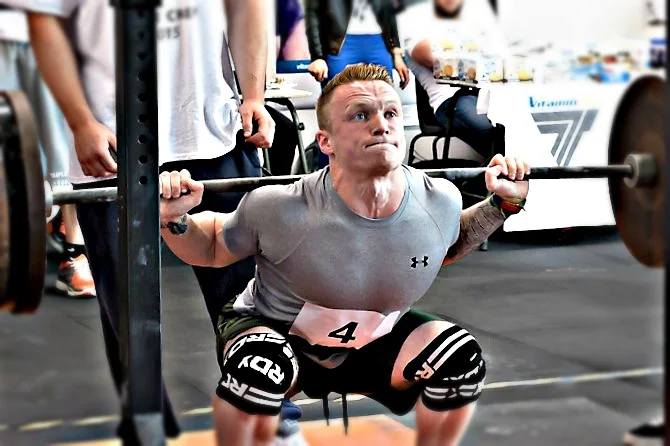RDL (Romanian Deadlift)
The RDL (Romanian Deadlift) is a compound hinge movement focusing on the hamstrings (back of legs), specifically the eccentric (way down) part of the exercise where we are trying to achieve maximum stretch through the hamstrings.
The starting position is holding the bar at hip level with a pronated grip. Your shoulders should be pinned back, your back neutral and your knees slightly bent.
Once you have a strong starting position, you’ll be ready to start the movement. Lower the bar by pushing your bottom back as far as you can. Keep the bar as close to your body as possible (it should slide down your legs) and keep your shoulders pinned back.
You’ll know when you’re doing it correctly as you’ll feel an incredible stretch in the hamstrings. Once you’ve reached full stretch (generally just below the knee), you can then start to bring the weight back up by driving your hips forward and locking out at the hip joint to achieve full squeeze of the glutes. Make sure your back stays straight through the full range of motion.
Key Coaching Points:
- Shoulder blades pinned back
- Slight bend in the knees
- Push your bottom out/push to the sky
- Keep the bar close to your body
Low-Fat vs Low-Carbohydrate [NEW STUDY]
Low-Fat vs Low-Carbohydrate
.........I honestly love it when a study like this is released! This study is particularly interesting due to its large group of participants, a staggering 12-month duration and careful dietary monitoring. Also, it was partially funded by NuSI, an organisation co-founded by low-carb advocates.
They randomly assigned 609 participants to either a healthy low-fat diet or a healthy low-carb diet for 12 months. During those 12 months, everyone was instructed to attend 22 dietary counselling sessions with a dietitian. While no calories targets were given, both groups were instructed to consume high-quality whole foods and drinks. They were told to maximise intake of vegetables and minimise intake of added sugars, refined flours and trans fats, also to focus on whole foods that were minimally processed, nutrient-dense, and prepared at home when possible.
The researchers looked to see if genotype or insulin production could predict weight loss on either a low-fat or a low-carb diet. Other health outcomes measured were weight change, body fat (DXA), cholesterol, blood pressure and fasting glucose.
Main findings were...
- No significant weight-loss differences were observed between the low-fat and low-carb groups!
- Neither genetics nor insulin production could predict weight-loss success on either diet!
- There were also no significant differences between groups for most other health markers tested!
Yes....triple shock!
The DIETFITS study replicates the results of numerous other studies, showing that when calorie intake and protein intake are consistent the amount of carbs or fat doesn't matter too much.
Summary
There will always be diet trends, people will always say "I have the diet for you!!" but.......in the end......it comes down to having a diet that you can stick with! Also, one that is abundant with whole and nutrient-dense foods whilst rich in protein.
References:
The DIETFITS Randomised Clinical Trial
How to Squat - The Perfect Squat In 14 Easy Steps
Step 1 - Stop avoiding the squat with your weak ass excuses….”I have bad knees’…”It hurts by shoulders”.
Step 2 - Grab the barbell shoulder width apart
Step 3 - Bring yourself under the bar whilst keeping your hands in the same position
Step 4 - Squeeze your shoulders blades together
Step 5 - Bring the bar to an almost comfortable position just above your shoulder blades and sitting across your posterior delts
Step 6- Brace your core and take a deep breath
Step 7 - Unrack the bar by squeezing your gluts, this will allow your hips to slightly drive forward and unrack the bar.
Step 8 - Walk the bar out with a minimal amount of steps
Step 9 - Make sure your feet are shoulder width apart and slightly facing outwards.
Step 10 - Exhale, then take a deep breath whilst re-bracing your glutes and core.
Step 11 - Start the squat by pushing your hips back and letting your knees track towards your toes, I suggest you slightly push your knees out to increase glute activation.
Step 12 - Once you have hit depth (thighs parallel to the ground), drive up by contracting your legs, driving your hips forward and knees slightly out
Step 13 - Take a second to appreciate how biomechanically awesome what you just did was.
Step 14 - Repeat
How To Stop Being A Gym Snowflake - 5 Easy Steps
Stop Avoiding Difficult Or Painful Exercises
Get Comfortable With Being Uncomfortable
Don’t Listen To People Who Say You Can’t Or SHOULDN’T
No Hip Thrust Pad For Squats
Overload (Track And Push To The Limit)







